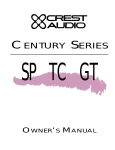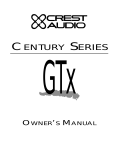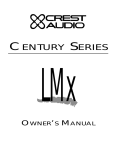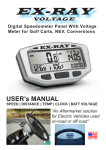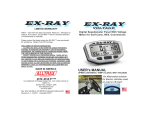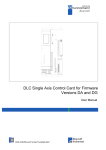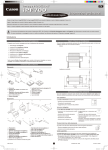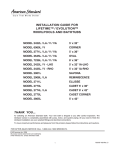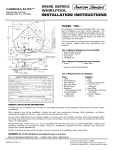Download Century 15 SERIES 15 Technical information
Transcript
C E N T U RY S E R I E S LM O WNER ' S M ANUAL Congratulations on your purchase of a Century Series console. All of us at Crest Audio in Paramus, New Jersey, USA, support your decision, knowing your console contains the finest combination of design and manufacture in the industry. While your new Century Series console is one of the most feature-packed available, great effort has been put into making it simple to operate. This manual explains the functions of your new console, how they operate and how they relate to each other. If properly cared for, your new console will provide you with trouble-free, sonically accurate mixing clear into the next Century and beyond. Please keep the following contact information on hand: Crest Audio Customer Service Dept. 100 Eisenhower Drive Paramus NJ 07652 USA TEL 201.909.8700 FAX 201.909.8744 http://www.crestaudio.com Crest Audio Inc. 100 Eisenhower Dr., Paramus NJ 07652 USA TEL: 201.909.8700 FAX: 201.909.8744 http://www.crestaudio.com Printed in USA TABLE OF CONTENTS LM Feature Overview 2 LM System Connections 3 A brief description of the LM design, features and functions. Contains diagrams illustrating conventional system connections. LM Wiring Conventions 5 Contains diagrams indicating how connectors for Crest consoles are wired. LM Power Supply 6 A description of the rack-mountable Century Series consoles power supply. LM Power Connections 7 A description of Crest console power connections. LM Console Cooling 7 A brief description of the dual-fan cooling setup. LM LM-12 Input Module 8 Profiles the LM-12 input module. The module is illustrated and described. LM LM-20 (LM-8+4) Input Module 10 Profiles the LM-20 (LM-8+4) input module. The module is illustrated and described. LM LM-12 Output Module 13 Profiles the LM-12 ouput module. The module is illustrated and described. LM LM 8+4 Output Module 15 Profiles the LM-8+4 output module. The module is illustrated and described. LM LM-20 Output Module 17 Profiles the LM-20 ouput module. The module is illustrated and described. LM Master Module A 19 Profiles the LM A-Master module. The module is illustrated and described. LM Master Module B 21 Profiles the LM B-Master module. The module is illustrated and described. LM Technical Information Appendix A Includes dimensions, specifications, console access details, user options, console block diagram, and rear panel layout. LM Glossary Appendix B LM Schematics Appendix C The specific details of console operation are described here, alphabetically. This appendix lists available LM console & power supply schematics. PAGE 1 LM CENTURY SERIES Feature Overview The Century Series was designed to have all the features and functions demanded by the modern music professional. The engineers at Crest Audio have delivered the finest combination of function and sonic accuracy in an affordable intuitive console. The features listed below are common to all Century Series LM Consoles. • SSM/PMI High quality devices on balanced microphone/line inputs and on all outputs for uncompromised audio quality and reliability. All IC’s within the audio path are socket mounted for easy upgrade or service. • The signal path is completely free of electrolytic capacitors and all internal audio connections are gold plated. • Passive microphone splitters on every microphone input. • 48 Volt switchable phantom power on all microphone inputs. • Optional transformers available on all microphone inputs and primary outputs. • Dynamic Signal Present and multiple-sample- point Peak indicator LED’s are used on all input sections of the console as well as on all primary outputs. • Mono/Stereo PFL system. When a stereo module is used, the signal is monitored in stereo while mono modules are monitored in mono. • Standard frame sizes include 32, 40, 44, 52 and 64 module positions. Any frame size may be ordered short loaded for later expansion. • The three banks of four rotary send controls each have an associated Pre switch. This switch can be internally selected to operate as pre EQ or pre Fader; this selection applies to all three Pre switches on the module. • Each of the twelve send controls can be internally selected to operate in one of three modes: follow its associated Pre switch, always Pre or always Post. • Mute system on input channels is designed to mute both pre and post fader signals. When muted, PFL circuitry and, Peak and Dynamic Signal Present LED indicators remain fully operational. This is a feature not available on many consoles at any cost. • Four scene (A-D) mute system • The EQ section includes an EQ IN switch with LED and a 100Hz High Pass filter switch. The EQ itself offers four bands (LF-40-800Hz, LMF-100Hz-2kHz, HMF-400Hz-8kHz, HF1.5k-20kHz) that are sweepable, providing full frequency control with generous overlap. The high and low frequency bands are selectable between Peaking and Shelving via internal jumpers. PAGE 2 • Each LM output Module (except those in the master module) has a ten-segment LED array, three-band sweepable EQ, EQ-In switch, variable high-pass filter, polarity reverse, Insert switch, Talkback enable, Dim, Peak & dynamic Signal Present LEDs, local Mute and PFL. • Return level controls provide signal from Returns 1 and 2 found on the Master section. The Sub Input controls deliver signal from outputs 11 and 12 which are selectable pre or post fader. This feature allows mixes 11 and 12 to be cross-mixed to all other outputs. • Comprehensive Talkback section allows access to all primary console outputs. External signals can also be assigned into the talkback system. • The basis of every Century console is signal integrity. From the input preamplifier's impressive EIN of -129 dBu, to completely balanced primary busing, the Century LM delivers one of the cleanest signals available at any cost. This signal purity comes from using only the highest quality components in its innovative design. All inputs and outputs are electronically balanced, the primary inputs and outputs have the option of transformer isolation. • UL/CE-approved external power supply over-designed with ample current reserves. For the ultimate in fail-safe reliability, a back-up power supply can be linked to the primary supply with only an inexpensive jumper cable. External switching is not needed. CENTURY SERIES LM LIVE MONITOR CONSOLE System Connections The console is the nerve center of a sound system and controls most of the variables within a system. Proper connection and component relationships are vital to assure accurate operation and results. The following diagrams illustrate conventional system connections. In Signal Processors Out Insert Send/Return Connection Front of House Console DIR OUT DIR OUT DIR OUT DIR OUT INSERT SEND INSERT SEND INSERT SEND INSERT SEND BAL INSERT RTN BAL INSERT RTN BAL INSERT RTN BAL INSERT RTN BAL LINE IN BAL LINE IN BAL LINE IN BAL LINE IN BAL MIC IN BAL MIC IN BAL MIC IN BAL MIC IN From Stage Microphones Microphone Splitting PAGE 3 CENTURY SERIES LM 6001 Professional Power Amplifier Clip/Limit Signal Temp/DC Active -6 -10 -6 -3 -10 -15 -3 -15 -1 -30 -80 -1 -30 0dB -80 Ch A 0dB Ch B 6001 Professional Power Amplifier Clip/Limit Signal Temp/DC Active -6 -10 -3 -6 -10 -15 -3 -15 -1 -30 -80 0dB Ch A -1 -30 -80 0dB Ch B Floor Wedge Connection Receivers for In-Ear Monitors Transmitters for In-Ear Monitors Stereo In-Ear Monitor Connection PAGE 4 CENTURY SERIES LM Wiring Conventions Since the same connectors are used throughout the professional audio industry, it is important to know how the connectors for Crest’s Century Series are wired. The wiring is as follows. OUTPUT XLR PIN 1 PIN 2 PIN 3 PIN 2 PIN 3 PIN 1 2 3 1 INPUT XLR PIN 1 = GROUND PIN 2 = POSITIVE PIN 3 = NEGATIVE TIP - POSITIVE RING - NEGATIVE INPUT SLEEVE - GROUND Output Plug Polarities TIP - POSITIVE TIP - SEND RING - NEGATIVE RING - RETURN SLEEVE - GROUND SLEEVE - GROUND INSERT OUTPUT Input Plug Polarities Insert send & Insert return Polarities PAGE 5 CENTURY SERIES LM Power Supply Century Series Consoles use a separate rack-mountable power supply which provides the specific voltages used by each console. Century Consoles make use of two different power supplies. The model and frame size of your particular console determines which of the two supplies should be used. Model Supply Model XCVA04 Supply Model XCVA06 LM Frame Size 24,32 Frame Size 40,44,52,64 Press to Reset +20V +48V ON 4A C O N S O L E S -20V +24V Power Supply POWER OUT 2 1 5 4 3 7 6 Pin Pin Pin Pin Pin Pin Pin 1 2 3 4 5 6 7 +24V +20V Analog Analog Digital +48V -20V CAUTION RISK OF ELECTRIC SHOCK DO NOT OPEN CONSOLE GROUND AVIS : RISQUE DE CHOC ÉLECTRIQUE—NE PAS OUVRIR CHASSIS GROUND WARNING TO REDUCE THE RISK OF FIRE OR ELECTRIC SHOCK DO NOT EXPOSE THIS EQUIPMENT TO RAIN OR MOISTURE. ATTENTION! POUR ÉVITER LE RISQUE D'INCENDIE OU DE CHOC ÉLECTRIQUE, NE PLACEZ PAS CET APPAREIL SOUS LA PLUIE OU Á L'HUMIDITÉ Designed & manufactured in the USA by: POWER OUT A division of Crest Audio Inc. 100 Eisenhower Dr. Paramus, New Jersey 07652 USA MAXIMUM AC IN: XCVA04: 415 WATTS XCVA06: 825 WATTS Model XCVA04 ± 20V @ 4 + 24V @ 4 + 48V @ 1 + 24V @ 6 ± 20V @ 6 S/N Model XCVA06 Supply Identification Twin Supply Operation The type of power supply can be identified by the model number shown on the back of the chassis and panel label. When twin supplies are in use for automatic back-up, then the ground links on both supplies should be fitted. In a situation where the safety ground to the console chassis has been connected and the ground path via the power supply is causing a hum-loop, then disconnect the ground links on BOTH power supplies. Power Requirements The Century Series power supplies have certain electrical requirements to operate properly. If possible the power supply should be connected to a dedicated circuit. Should any other appliance on the same circuit draw enough current to overload the circuit, the breaker or fuse will trip causing loss of power to the console. Note the maximum current draw specifications at right. Be sure that the circuit to which you connect the supply can handle the draw. The power switch on the supply front panel is also a circuit breaker, there is no power fuse. Should the supply ever shut down, or trip at start up, simply push the switch to the off position and then on again. Ground Linking Safety Considerations - Each new power supply is shipped with the AC third wire ground connected to the console chassis ground. The connection is made at the rear of the power supply unit. This is necessary for safety reasons so that exposed metal parts are grounded. In the event of a live conductor making contact with the console chassis or the power supply chassis then the current will flow to ground without a safety hazard arising. Note that when the console is disconnected from the power supply the chassis ground connection to AC third wire ground is broken and safety protection is lost. For uninterruptible grounding, in a fixed installation for example, make a connection directly to the console chassis from the safety ground. Disconnect the ground link on the rear of the power supply. This disconnects console ground from power supply AC third wire ground which would otherwise create a hum-loop. PAGE 6 Console and Power Supply Grounding Console chassis ground is electrically connected to audio ground, pin 1 of XLR connectors and 1/4" sockets and to the terminal ‘CONSOLE GROUND’ at the rear of the power supply. The AC third wire connection in the power supply cable connects the metal chassis of the power supply to safety ground. This connection should never be disturbed. Hazardous voltages exist inside the power supply which require the case to be grounded. When rack-mounted, the power supply ground may transfer to the rack case thru the front fixing screws, though this connection is not reliable. When a console is configured within a complete sound system the grounding requirements may call for the ground link to be disconnected. This is permissible only when an alternative ground path has been provided. If in doubt seek the Model XCPS-40 advice of an experienced elec±20V @ 4 S/N trical engineer. +24V @ 4 +48V @ 1A +24V @ 6A ±20V @ 6A Model XCVA06 Power Supply Model Max Current Draw 120V/230V XCVA04 XCVA06 7A/4A 9A/5A CENTURY SERIES LM Power Connections The connections to and from the power supply vary depending on your specific configuration. Multiple power supplies can be daisy-chained to provide fail-safe protection in the event of a supply failure. When two or more supplies are used, they may be connected to the same mains voltage since only one of the supplies will actually be feeding the console at any given time. The connectors on the power supply are “smart” so that either one can be used as the console or interface connection. To Console POWER OUT 2 1 5 4 3 7 6 Pin Pin Pin Pin Pin Pin Pin 1 2 3 4 5 6 7 +24V +20V Analog Analog Digital +48V -20V CAUTION RISK OF ELECTRIC SHOCK DO NOT OPEN CONSOLE G RO UND AVIS : RISQUE DE CHOC ÉLECTRIQUE—NE PAS OUVRIR CHASSIS GROUND WARNING TO REDUCE THE RISK OF FIRE OR ELECTRIC SHOCK DO NOT EXPOSE THIS EQUIPMENT TO RAIN OR MOISTURE. ATTENTION! POUR ÉVITER LE RISQUE D'INCENDIE OU DE CHOC ÉLECTRIQUE, NE PLACEZ PAS CET APPAREIL SOUS LA PLUIE OU Á L'HUMIDITÉ Designed & manufactured in the USA by: POWER OUT A division of Crest Audio Inc. 100 Eisenhower Dr. Paramus, New Jersey 07652 USA MAXIMUM AC IN: XCVA04: 415 WATTS XCVA06: 825 WATTS Model XCVA04 ± 20V @ 4 + 24V @ 4 + 48V @ 1 + 24V @ 6 ± 20V @ 6 S/N To AC Mains Model XCVA06 Interface Cable POWER OUT 2 1 5 4 3 7 6 Pin Pin Pin Pin Pin Pin Pin 1 2 3 4 5 6 7 +24V +20V Analog Analog Digital +48V -20V CAUTION RISK OF ELECTRIC SHOCK DO NOT OPEN CONSOLE GROUND AVIS : RISQUE DE CHOC ÉLECTRIQUE—NE PAS OUVRIR WARNING TO REDUCE THE RISK OF FIRE OR ELECTRIC SHOCK DO NOT EXPOSE THIS EQUIPMENT TO RAIN OR MOISTURE. ATTENTION! POUR ÉVITER LE RISQUE D'INCENDIE OU DE CHOC ÉLECTRIQUE, NE PLACEZ PAS CET APPAREIL SOUS LA PLUIE OU Á L'HUMIDITÉ Designed & manufactured in the USA by: POWER OUT A division of Crest Audio Inc. 100 Eisenhower Dr. Paramus, New Jersey 07652 USA Model XCVA04 ± 20V @ 4 + 24V @ 4 + 48V @ 1 + 24V @ 6 ± 20V @ 6 CHASSIS GROUND MAXIMUM AC IN: XCVA04: 415 WATTS XCVA06: 825 WATTS S/N Model XCVA06 To AC Mains Console Cooling A cooling fan configuration is included in all LM consoles except the LM-12 and the 32-chassis space LM Dual/Stereo models. Two fans (one at each end of the console) draw air in through the sides of the chassis (under the sidebars). Air is distributed through the chassis via a “vortex pan”, then proceeds up through the console modules, where the heated air exits the console chassis. Once the console is powered up, cooling fans remain on. A rear panel switch permits the fans to be set at low, medium or high speeds. There are no filters to change or clean. As with any console, use in dusty/unclean environments should be avoided. PAGE 7 CENTURY SERIES LM 3 7 2 9 4 5 4 6 3 7 2 8 1 9 10 0 PAD GAIN 20 The LM-12 input module is the primary input control for the LM12 monitor console. It differs from the LM-20 input module only in the mix send section. 10 0 +48V LINE LM-12 INPUT MODULE 8 1 48V Phantom Power Switch PRE Turns on 48V Phantom Power as required by certain microphones for proper operation. 30 10 4 5 5 6 3 6 60 7 2 8 100 0 4 ø 10 5 7 2 8 9 1 HF 0 10 3 4 5 1.5 1K 8 4 5 7 2 8K Reduces all low frequency content at a 12db per octave rate referenced to 100Hz (-3db point). 10 0 1 250 100Hz High Pass Switch 8 9 1 LM Adjusts input gain for proper signal level. 8 6 3 400 GAIN Control 9 10 0 6 400 Introduces a -15 dB cut to the mic input signal. 7 1 HM 3 7 6 2 20K PAD Switch 10 3 2K Selects between the Balanced XLR Microphone Input connector and the Balanced Line Input 1/4" TRS connector. 6 6 3 4 LINE Switch 9 1 PRE 2K 100 150 4 LF 3 100 5 8 1 4 10 5 7 2 8 1 9 0 4 4 5 8 1 4 8 5 7 8 1 9 0 There are two knobs for each of the four bands. The inner knob controls the boost or cut; while the outer knob controls the center frequency. These center frequencies are printed on the chassis around the outer knob. EQ IN Switch 12 6 2 2 6 3 10 3 10 5 DIR OUT 9 0 9 0 11 6 7 7 2 4 5 3 1 1 10 2 6 3 Four-Band Sweep Equalizer Controls 10 6 3 PRE Inverts the polarity of both the microphone and line inputs. 9 0 800 EQ IN Polarity Reverse Switch 7 2 6 40 9 6 3 INSRT SND 10 Inserts the EQ section into the input channel signal. An associated LED illuminates when the switch is down. 7 2 PRE Switch 1-4 MUTE 8 9 1 10 0 4 5 BAL INSRT RTN 3 6 3 PFL 7 2 Toggles mix sends 1-4 between Post and the internally selected Pre state. 8 1 PEAK 9 10 0 4 5 Mix Sends 1-4 SIG 4 6 3 BAL LINE IN 7 2 8 1 PRE Switch 5-8 9 0 10 LIFT PIN 1 PRE 4 5 2 BAL MIC IN A 7 8 B 0 4 10 5 C 6 6 3 D 7 2 10 8 9 1 0 4 10 5 7 6 3 2 8 SCENE MUTE SELECT 9 1 10 0 4 5 8 6 3 7 2 8 9 1 10 0 PRE 4 5 3 2 1 PAGE 8 9 6 7 8 9 20 SAFE 7 Mix Sends 5-8 Adjusts signal level sent to output mixes 5-8 5 9 1 Toggles mix sends 5-8 between Post and the internally selected Pre state. 0 5 6 3 Adjusts signal level sent to output mixes 1-4 BAL MIC OUT PRE Switch 9-12 Toggles mix sends 9-12 between Post and the internally selected Pre state. Mix Sends 9-12 Adjusts signal level sent to output mixes 9-12 30 40 MUTE Switch with LED Mutes the channel and all sends except the insert send. This switch does not affect the PFL switch or the Peak and Signal Present LED indicators, The LED illuminates when the channel is muted either from the local mute switch or the scene mute system. CENTURY SERIES PFL Switch Samples the channel’s signal pre-fader and allows for monitoring within the master section of the console. This signal is not affected by the Mute Switch. When depressed, the signal level can be seen on the output 12 meter, and heard via the mixer’s headphone or local monitor output. When this PFL Switch is depressed, the channel PEAK LED indicator illuminates at a lower intensity. When used as a status indicator of switch position, the Peak LED indicating circuit remains fully operational by illuminating at a much higher intensity than when indicating PFL status. PEAK LED Indicator LM Rear Panel Connections Direct Out This 1/4-inch TRS jack carries the direct output signal (post fader & post mute) from the associated input channel. Insert Send This 1/4-inch TRS jack carries the send signal of the insert loop to the external effect or signal processor. Balanced Insert Return This 1/4-inch TRS jack accepts the return signal of the insert loop from the external effect or signal processor back into the console. Illuminates RED when any of the points monitored come within 3db of the clipping point. Signal is sampled after the input preamplifier stage, after the EQ section, and after the fader. Balanced Line In This LED also serves as a PFL ON indicator, but at a much lower intensity than when it is used to indicate clipping. Lift Pin 1 SIGNAL PRESENT LED This green LED constantly displays level activity of the input channel by varying in intensity. 100mm Fader This 1/4-inch TRS jack accepts balanced and unbalanced line level inputs and delivers it into the associated input channel. This ground lift switch may be used to isolate pin1 of the mic XLR from console ground. Unpressed = pin 1 grounded Pressed = pin 1 lifted Used for control of all outputs of the channel except those sends selected pre fader. (The Insert Output level is not affected by the fader position.) Balanced Mic In Scene Mute Assignments Balanced Mic Out Assign the input channel to any of the four scene mute groups. Scene mute combines with the module’s local mute button, and actuates the local mute LED. This XLR connector is in parallel with the Balanced Mic In connector and allows easy connection of the monitor board to the FOH console. This XLR connector accepts balanced microphone inputs for the associated input channel. Scene Mute Safe Switch Disables any selected scene mute assignments. An associated green LED indicates that the channel is in a safe state. PAGE 9 CENTURY SERIES LM 3 7 2 9 4 5 4 6 3 7 2 8 1 9 0 PAD 10 GAIN 20 This module serves as the input module for LM-20 and the nowdiscontinued LM-8+4. The only difference between the two is the factory default settings on the dual concentric sends.For the LM-20 the sends are set for level/level operation. For an LM8+4 the sends are set for level/pan operation. 10 0 +48V LINE LM-20 (LM-8+4) INPUT MODULE 8 1 PRE 30 4 10 5 6 7 2 60 9 10 0 100 4 5 6 6 3 8 0 10 4 10 5 4 400 5 8 6 3 7 2 8K GAIN Control 8 Adjusts input gain for proper signal level. 9 1 LM 400 Introduces a -15 dB cut to the mic input signal. 10 0 6 PAD Switch 8 9 1 3 HM 1K 7 2 20K 1.5 7 6 3 2K Selects between the Balanced XLR Microphone Input connector and the Balanced Line Input 1/4" TRS connector. 9 1 HF 4 LINE Switch 7 2 3 Turns on 48V Phantom Power as required by certain microphones for proper operation. 8 1 ø 48V Phantom Power Switch 5 6 3 10 0 1 250 100Hz High Pass Switch PRE 2K 100 150 4 LF 3 5 6 3 7 2 100 6 8 1 9 0 800 40 4 5 10 6 8 1 9 0 4 4 5 11 6 8 1 1 6 5 12 6 7 2 10 0 4 5 3 9 9 0 INSRT SND 10 7 2 9 10 0 4 5 3 6 3 BAL INSRT RTN PFL 7 2 8 1 4 SIG 10 0 5 4 6 3 BAL LINE IN 7 2 8 1 9 0 10 PRE 0 4 5 5 6 3 7 2 8 0 4 B 10 5 D 7 10 8 9 1 10 4 5 7 6 3 2 8 SCENE MUTE SELECT 9 1 4 10 5 8 6 3 7 2 8 10 0 4 2 1 5 9 6 7 8 9 PAGE 10 BAL MIC OUT Mix Sends 5-8 Adjusts signal level sent to stereo output mixes 5-8 or mono mixes 5a through 8b. PRE Switch 9-12 30 40 Toggles mix sends 9-12 between Post and the internally selected Pre state. Adjusts signal level sent to stereo output mixes 9-12 or mono mixes 9a through 12b. PRE 3 PRE Switch 5-8 Mix Sends 9-12 9 1 20 SAFE 7 0 Adjusts signal level sent to stereo output mixes 1-4 or mono mixes 1a through 4b. C 2 0 Mix Sends 1-4 Toggles mix sends 5-8 between Post and the internally selected Pre state. 5 6 6 3 LIFT PIN 1 BAL MIC IN A 9 1 PRE Switch 1-4 Toggles mix sends 1-4 between Post and the internally selected Pre state. PEAK 9 EQ IN Switch Inserts the EQ section into the input channel signal. An associated LED illuminates when the switch is down. MUTE 8 1 There are two knobs for each of the four bands. The inner knob controls the boost or cut; while the outer knob controls the center frequency. These center frequencies are printed on the chassis around the outer knob. 8 1 2 6 3 10 0 4 8 DIR OUT 9 7 1 7 2 2 Four-Band Sweep Equalizer Controls 10 5 3 3 Inverts the polarity of both the microphone and line inputs. 7 2 PRE Polarity Reverse Switch 10 3 EQ IN Reduces all low frequency content at a 12db per octave rate referenced to 100Hz (-3db point). 9 CENTURY SERIES MUTE Switch with LED Mutes the channel and all sends. This switch does not affect the PFL switch or the Peak and Signal Present LED indicators, The LED illuminates when the channel is muted either from the local mute switch or the scene mute system. PFL Switch Samples the channel’s signal pre-fader and allows for monitoring within the master section of the console. This signal is not affected by the Mute Switch. When depressed, the signal level can be seen on the output 12 meter, and heard via the mixer’s headphone or local monitor output. When this PFL Switch is depressed, the channel PEAK LED indicator illuminates at a lower intensity. When used as a status indicator of switch position, the Peak LED indicating circuit remains fully operation by illuminating at a much higher intensity than its use as a PFL status indicator. LM Rear Panel Connections Direct Out This 1/4-inch TRS jack carries the direct output signal (post fader & post mute) from the associated input channel. Insert Send This 1/4-inch TRS jack carries the send signal of the insert loop to the external effect or signal processor. Balanced Insert Return This 1/4-inch TRS jack accepts the return signal of the insert loop from the external effect or signal processor back into the console. Balanced Line In This 1/4-inch TRS jack accepts balanced and unbalanced line level inputs and delivers it into the associated input channel. PEAK LED Indicator Lift Pin 1 Illuminates RED when any of the points monitored come within 3db of the clipping point. Signal is sampled after the input preamplifier stage, after the EQ section, and after the fader. This ground lift switch may be used to isolate pin1 of the mic XLR from console ground. This LED also serves as a PFL ON indicator, but at a much lower intensity than when it is used to indicate clipping. Pressed = pin 1 lifted SIGNAL PRESENT LED This XLR connector accepts balanced microphone inputs for the associated input channel. Constantly displays level activity of the input channel by varying in intensity. 100mm Fader Used for control of all outputs of the channel except those Aux output sections selected by switch to a pre fader position. (The Insert Output level is not affected by the fader position.) Unpressed = pin 1 grounded Balanced Mic In Balanced Mic Out This XLR connector is in parallel with the Balanced Mic In connector and allows easy connection of the monitor board to the FOH console. Scene Mute Assignments Assign the input channel to any of the four scene mute groups. Scene mute combines with the module’s local mute button, and actuates the local mute LED. Scene Mute Safe Switch Disables any selected scene mute assignments. An associated green LED indicates the channel is in a safe state. PAGE 11 CENTURY SERIES LM 4 20 OUTPUT 2 40 +9 RETURN +6 +3 4 5 6 3 0 7 2 -3 1 9 0 -6 4 -9 1 5 6 3 -12 2 7 2 8 1 -15 1 8 9 0 1 -18 5 SUB INPUT 4 5 6 1 3 7 1 3 1 1 2 20 HF O + 8 1 9 0 8 8 4 3 1 1 5 6 1 7 2 1 8 1 1 3 9 0 60 1 5 8 30 MID O + 8 ø 8 1 1 15 30 10 INSERT ON 6 1 4 LF TB ENB O + 8 8 BAL OUT 1 1 DIM EQ IN MUTE INSERT SEND HPF 8 10 PFL 4 20 PEAK 2 40 RETURN 4 1 5 6 3 7 2 1 8 1 INSERT RTN SIG 5 9 0 4 1 5 6 3 0 7 2 2 8 1 9 0 5 1 10 SUB INPUT 4 5 6 1 3 7 2 8 1 9 0 4 3 30 1 5 6 1 7 2 8 1 9 0 1 ø PAGE 12 20 40 CENTURY SERIES LM LM-12 Output Module The LM-Mono Group output module is the primary output module on the LM-12 and the secondary output module on the LM-8+4 and the LM-20 Output PEAK & Signal LEDs Output Meter The green LED constantly displays the level of signal activity by varying in intensity. Monitors the post-fader output signal via a ten-segment LED array. Output EQ Controls the the equalization of the output mix signal through three bands, via six controls. The upper knob of each band determines the center frequency (high-1kHz-20kHz, mid300Hz-8kHz, low-40Hz, 1kHz), while the lower knob adjusts the amount of boost or cut. The red LED indicates that the output is within 3dB of the clipping point. Output Fader Controls the final output signal level. Rear Panel Connections Balanced Out This XLR connector carries the post-fader output signal from the associated output module. EQ IN Switch Output Insert Send Inserts the EQ section into the output channel signal. An associated LED illuminates when the switch is down. This 1/4-inch TRS balanced jack carries the send signal of the output insert loop to the external effect or signal processor. High Pass Filter Switch Output Insert Return Inserts the High Pass Filter into the output signal. This 1/4-inch TRS balanced jack accepts the return signal of the output insert loop from the external effect or signal processor. HPF Frequency Control This knob adjusts the high pass filter frequency from 20Hz to 400Hz. The filter operates at a -12 dB per octave rate. Return Level Controls Adjusts the level of return signals 1 and 2 in the output. These signals come from the Master Section. See Returns 1 & 2 on the Master Section description for more information. Sub Input Controls Adjusts the level of cross-mix in the output from mono outputs 11 and 12. Polarity Reverse Switch Inverts the polarity of the output. Insert On Switch Turns on the insert loop for the output signal. If a complete insert loop is not present depressing this switch will mute the output. TB Enable Switch Injects the talkback signal from the master section into the group output. DIM Switch Introduces a -6dB drop to the output signal. This is a push on/push off switch, not momentary. MUTE Switch with LED Mutes the output. This switch does not affect the PFL switch or the Peak and Signal Present LED indicators. Output PFL Enables Pre Fader Listening of the output signal. (this signal can be internally selected post fader) PAGE 13 CENTURY SERIES LM 100 40 200 OUTPUT 400 20 +9 RETURN +6 +3 4 9 0 4 -9 8 1 9 0 -18 3 15 20K 2 HF 8 8 1 8 9 0 10 4 5 6 12 7 3 16 1K 10 SUB INPUT 4 5 6 11 3 7 10 O + 2 8 1 3 9 0 600 2 7 2 -15 16 10 5 6 3 -12 1 8 1 -6 1K 7 2 -3 5 5 6 3 0 10 5 MONO 8K 300 MID O + 8 Ø 8 16 16 150 300 100 INSERT ON 6 1K 40 LF O + 8 TB ENB 8 BAL OUT LEFT 16 16 DIM EQ IN MUTE INSERT SEND HPF 80 100 PFL 40 200 INSERT RETURN PEAK 20 400 SIG RETURN 4 5 6 3 7 2 1 8 1 5 BAL OUT RIGHT 9 0 4 10 5 6 3 0 2 7 2 INSERT SEND 8 1 9 0 5 10 10 SUB INPUT 4 5 6 11 3 7 2 20 8 1 9 0 10 4 5 6 12 7 3 2 30 8 1 9 0 10 MONO Ø PAGE 14 INSERT RETURN 40 CENTURY SERIES LM LM-8+4 Output Module The LM-Stereo group output module is the primary output module on the discontinued LM-8+4. Output Meters Monitors the post-fader output signal via two ten-segment LED arrays. Output EQ Controls the the equalization of the output mix signal through three bands, via six controls. The upper knob of each band determines the center frequency (high-1kHz-20kHz, mid300Hz-8kHz, low-40Hz, 1kHz), while the lower knob adjusts the amount of boost or cut. EQ IN Switch Inserts the EQ section into the output channel signal. An associated LED illuminates when the switch is down. High Pass Filter Switch Inserts the High Pass Filter into the output signal. HPF Frequency Control This knob adjusts the high pass filter frequency from 20Hz to 400Hz. The filter operates at a -12 dB per octave rate. Return Level Controls Adjusts the level of return signals 1 and 2 in the output. These signals come from the Master Section. The center knob adjusts level while the outer knob adjusts panning within the stereo image. See Returns 1 & 2 on the Master Section description for more information. MUTE Switch with LED Mutes the output. This switch does not affect the PFL switch or the Peak and Signal Present LED indicators. Output PFL Enables Pre Fader Listening of the output signal. (this send can be internally selected post fader) Output PEAK & Signal LEDs The red LED indicates that the output is within 3dB of the clipping point. The green LED constantly displays the level of signal activity by varying in intensity. Output Fader Controls the final output signal level Rear Panel Connections (L & R) Balanced Out This XLR connector carries the post-fader output signal from the associated output module. Output Insert Send This 1/4-inch TRS balanced jack carries the send signal of the output insert loop to the external effect or signal processor. Output Insert Return This 1/4-inch TRS balanced jack accepts the return signal of the output insert loop from the external effect or signal processor. Sub Input Controls Adjusts the level of cross-mix in the output from mono outputs 11 and 12. The center knob adjusts while the outer knob adjusts panning within the stereo image. Mono Switch Depressing this switch mixes the left and right pre-insert signals together onto the Left Insert Send jack. The Left Insert Return is switched to both Left and Right Returns. This allows for a mono processor to be used, but affect both channels. Polarity Reverse Switch Inverts the polarity of the output. Insert On Switch Turns on the insert loop for the output signal. If a complete insert loop is not present depressing this switch will mute the output. TB Enable Switch Injects the talkback signal from the master section into the group output. DIM Switch Introduces a -6dB drop to the output signal. This is a push on/push off switch, not momentary. PAGE 15 CENTURY SERIES LM 40 200 20 OUTPUT 400 +9 RETURN +6 5 6 4 +3 3 0 7 2 1 -3 -6 -9 9 0 10 4 5 6 3 8 1 -15 2 7 2 -12 1 8 9 0 10 -18 5 SUB INPUT 4 5 6 11 3 7 10 3 15 1K 2 20K HF O + 8 8 16 9 0 10 4 5 6 12 7 3 2 16 1K 8 1 8 1 9 0 3 600 5 10 A B 8K 300 MID O + 8 Ø 8 INSERT ON 16 16 150 300 100 6 TB ENB 1K 40 LF O + DIM 8 8 16 BAL OUT LEFT 16 PEAK EQ IN SIG INSERT SEND MUTE HPF 80 100 INSERT RETURN 40 200 PFL 20 400 RETURN 4 5 6 3 7 2 1 BAL OUT RIGHT 5 8 1 9 0 10 4 5 6 3 0 2 INSERT SEND 7 2 8 1 5 9 0 10 10 INSERT RETURN SUB INPUT 4 5 6 11 3 7 2 8 1 9 0 10 4 5 6 12 7 3 2 8 1 9 0 10 A B Ø PAGE 16 20 30 40 CENTURY SERIES LM LM-20 Output Module The LM-Dual group output module is the primary output module on the LM-20. Output Meter Output PEAK & Signal LEDs The red LED indicates that the output is within 3dB of the clipping point. Monitors the post-fader output signal via two ten-segment LED arrays. The green LED constantly displays the level of signal activity by varying in intensity. Output EQ Output Faders Controls the the equalization of the output mix signal through three bands, via six controls. The upper knob of each band determines the center frequency (high-1kHz-20kHz, mid300Hz-8kHz, low-40Hz, 1kHz), while the lower knob adjusts the amount of gain or cut. This single set of knobs controls both channels A & B. Controls the final output level of each signal (a & b). EQ IN Switch Output Insert Send Inserts the EQ section into the output channel signal. An associated LED illuminates when the switch is down. This 1/4-inch TRS balanced jack carries the send signal of the output insert loop to the external effect or signal processor. High Pass Filter Switch Output Insert Return Inserts the High Pass Filter into the output signal. This 1/4-inch TRS balanced jack accepts the return signal of the output insert loop from the external effect or signal processor. HPF Frequency Control This knob adjusts the high pass filter frequency from 20Hz to 400Hz. The filter operates at a -12 dB per octave rate. This single knob controls both channels A & B. Rear Panel Connections (L & R) Balanced Out This XLR connector carries the post-fader output signal from the associated output module. Return Level Controls Adjusts the level of return signals 1 and 2 in the output. These signals come from the Master Section. The center knob adjusts “level A” while the outer knob adjusts “level B.” See Returns 1 & 2 on the Master Section description for more information. Sub Input Controls Adjusts the level of cross-mix in the output from mono outputs 11 and 12. The center knob adjusts “level a” while the outer knob adjusts “level b.” Polarity Reverse Switch Inverts the polarity of the output. Insert On Switch Turns on the insert loop for the output signal. If a complete insert loop is not present depressing this switch will mute the output. TB Enable Switch Injects the talkback signal from the master section into the group output. DIM Switch Introduces a -6dB drop to the output signal. This is a push on/push off switch, not momentary. MUTE Switch with LED Mutes the output. This switch does not affect the PFL switch or the Peak and Signal Present LED indicators. Output PFL Enables Pre Fader Listening of the output signal. (This send can be internally selected post fader) PAGE 17 CENTURY SERIES LM OUTPUT BAL OUT INSERT SEND INSERT RTN MONITOR A LEFT MONITOR A RIGHT EXT TB IN PAGE 18 CENTURY SERIES LM LM Master Module A Output 11 Talkback Enable This the first of two modules that include master controls for all LM consoles in addition to mono output eleven. Injects the talkback signal from the master section into the group output. Output Meter Output 11 Dim Switch Monitors the post-fader output signal of group 11 via a tensegment LED array. Introduces a -6dB drop to the output signal. This is a push on/push off switch, not momentary. Monitor Level A Output 11 Mute Switch Adjusts the output level of local monitors A. Monitor Mute A Mutes local monitor A. Sub 11 Post Switch Switches the subgroup send between pre and post fader. Sub 11 On Switch Switches the subgroup send on and off. Lamp Dim Control Mutes the output. This switch does not affect the PFL switch or the Peak and Signal Present LED indicators. Output 11 PFL Switch Enables Pre Fader Listening of the output signal. (This can be internally selected to post fader) Output 11 Peak & Signal LEDs The red LED indicates that the output is within 3dB of the clipping point. The green LED constantly displays the level of signal activity by varying in intensity. Controls the brightness of any 12 volt lighting devices attached to the XLR connectors on the light bar. Output 11 100mm Faders Power Indicators Rear Panel Connections Output 11 Bal Out Shows the status of the four voltages used by the console. Phantom Master Switch w/LED Switches +48V phantom power on and off for the entire console. Input/Output PFL Indicators These LEDs indicate what type of signal (input or output) is PFL’d at any given time. Input PFL always gets priority over output PFL. Input Fader Mix Switch Sums all input mixes and assigns the summed signal to the Monitor A output. This output is stereo when stereo signals are present. This signal is post fader. Return Master Peak & Signal LEDs The red LED indicates that the output is within 3dB of the clipping point. The green LED constantly displays the level of signal activity by varying in intensity. Return Master PFL Switch PFLs the return signal. Controls the final signal level of outputs 11. This XLR connector carries the post-fader output signal from the output group 11 Insert Send This 1/4-inch TRS balanced jack carries the send signal of the output insert loop to the external effect or signal processor. Insert Return This 1/4-inch TRS balanced jack accepts the return signal of the output insert loop from the external effect or signal processor. Monitor A Out (L&R) These two connectors deliver local monitor A ‘s balanced output signal. Oscillator / Pink Noise In This 1/4-inch connector accepts a balanced or unbalanced signal from an oscillator or pink noise generator. This signal is assignable via the talkback assignment switches. Return Master Mute Mutes the return signal Return Master Level Controls Controls the final return signal level. Output 11 Polarity Reverse Inverts the polarity of outputs 11. Output 11 Insert On Switch Turns on the insert loop for the output signal. If a complete insert loop is not present depressing this switch will mute the output. PAGE 19 CENTURY SERIES LM OUTPUT BAL OUT INSERT SEND INSERT RTN MONITOR B LEFT MONITOR B RIGHT OSC IN PAGE 20 CENTURY SERIES LM LM Master Module B This the second of two modules that include master controls for all LM consoles in addition to mono output twelve. Output Meter Monitors the post-fader output signal of group 12 via a tensegment LED array. This meter also indicates PFL level. PFL Indicator This LED illuminates when the signal on meter 12 is a PFL or AFL signal Talkback Mic Input Allows for connection of a gooseneck or other XLR type microphone to the talkback system. Phantom power is available here for condenser mics. Headphone Jack Output 12 Insert On Switch Turns on the insert loop for the output signal. If an incomplete insert loop is present, depressing this switch will mute the output Output 12 Talkback Enable Injects the talkback signal from the master section into the group output. Output 12 Dim Switch Introduces a -6dB drop to the output signal. This is a push on/push off switch, not momentary. Output 12 Mute Switch Mutes the output. This switch does not affect the PFL switch or the Peak and Signal Present LED indicators. Allows for connection of headphones via a 1/4" TRS plug. Output 12 PFL Switch Headphone Level Control Enables Pre Fader Listening of the output signal. (This can be internally selected to post fader) Controls the output level of both headphone jacks. Group Mix Switch Sums all output mixes and assigns the summed signal to the Monitor B output. This output is stereo when stereo signals are present. This signal is post fader. Monitor Level B Adjusts the output level of local monitor B. Monitor Mute B Mutes local monitor B. Oscillator On Output 12 Peak & Signal LEDs The red LED indicates that the output is within 3dB of the clipping point. The green LED constantly displays the level of signal activity by varying in intensity. Output 12 100mm Fader Controls the final signal level of outputs12. Scene Mute Masters These four switches turn the four scene mutes on and off for the entire console. Switches on the internal 1kHz oscillator. The internal oscillator only operates when the Talkback system is engaged. Rear Panel Connections Output 12 Bal Out External TB Input Switch This XLR connector carries the post-fader output signal from the output group 12. Adds an external signal to the internal talkback signal. This signal is patched in via the external talkback connector on the back of the master module. Talkback Level Control Insert Send This 1/4-inch TRS balanced jack carries the send signal of the output insert loop to the external effect or signal processor. Adjusts the final level of all talkback signals. Insert Return External TB Output Switch This 1/4-inch TRS balanced jack accepts the return signal of the output insert loop from the external effect or signal processor. Feeds signal to the external talkback output connection. Only the internal talkback signal is present at this connector. Talkback Master On/Off Monitor B Out (L&R) Switches the internal talkback system on and off These two connectors deliver local monitor B ‘s balanced output signal. Sub 12 Post Switch Ext. Talkback In Switches the subgroup send between pre and post fader. Sub 12 On Switch This connector accepts a balanced signal which is assignable to any of the locations in the talkback system. Switches the subgroup send on and off. Output 12 Polarity Reverse Inverts the polarity of output 12. PAGE 21 LM Appendix A Technical Information CENTURY SERIES LM Specifications The following are the technical specifications for the Century LM console. Frequency Response +0.0, -0.5dB, 20Hz to 20 kHz (referenced to 1kHz) Total Harmonic Distortion Mic input to Group output 20Hz to 20 kHz at +15dBu <0.01% Noise (22Hz to 22kHz) Mic EIN Group Output Noise (20 ch routed)- -129 dBu 80 dBu Crosstalk (Measured at 1kHz) Channel Mute Channel Fader Attenuation Channel Routing >102 dB > 96 dB > 85 dB Input/Output Impedances Mic Input Line Input Outputs 4kΩ balanced >10kΩ balanced 140Ω balanced Input/Output Levels (0VU = +4 dBu, 1.23V RMS) Mic Input Sensitivity + 4 to -62 dBu Line Input Sensitivity + 12 to -38 dBu Input Insertion Point Level + 4 dBu Output Insertion Point Level - 2 dBu Nominal Output Level + 4 dBu Maximum Balanced Output Level +28 dBu Configurations Century LM Consoles are available in the following configurations: LM-12 (12 mono outputs) 12, 20, 28, 32, 40, or 52 inputs LM-20 (20 mono outputs) 12, 20, 28, 32, 40, or 52 inputs APPENDIX A Architect’s & Engineer’s Specifications The following text should be used when specifying a Century LM in a bid or proposal. The monitor console shall be constructed in a modular fashion and be housed in a steel frame with molded plastic side panel/carrying handles. The console shall be black with white labeling and utilize XLR lighting device connectors. All microphone inputs shall be electronically balanced and accessed via 3-pin XLR connectors and have an EIN of -129 dBm. All line inputs shall be electronically balanced and accessed via 1/4" TRS jacks. The insert points shall have discrete send and return connectors. Each input channel shall have: a +48 volt phantom power switch, a -15 dB mic pad switch, a 100Hz high pass filter switch, a polarity reverse switch and 4-band (LF-40-800Hz, LMF-100Hz-2kHz, HMF400Hz-8kHz, HF-1.5k-20kHz) sweepable EQ with selectable peak/shelve settings on the high and low controls and an EQ In switch. Each input channel shall also have: a FET controlled (10 millisecond ramp) mute switch with LED, dynamic signal present LED and peak LED, 4 scene mute switches (AD) each with LED, scene mute safe switch with LED and a 100mm long throw fader. Each input channel shall have output send controls appropriate to the specified model. Each bank of four rotary controls shall have an associated pre switch which shall be internally elected to operate as pre EQ or pre Fader; this selection shall apply to all three pre switches on the input. Each of the send controls shall be internally selectable to operate in one of three modes: follow its associated pre switch, always pre or always post. The console shall be available in two output configurations: 12 mono or 20 mono. Each output shall have a ten-segment LED array, three-band sweepable EQ, EQ-In switch, variable high-pass filter, polarity reverse, insert switch, talkback enable, dim, peak & dynamic signal present LEDs, local mute and PFL. The mono outputs shall have mono EQ, the stereo outputs shall have stereo EQ; while the dual mono outputs shall have stereo EQ but with separate A/B EQ In switches. The master section shall be contained within mono outputs 11 and 12 and shall contain: a talkback system, scene mute master controls, return master controls and two stereo local monitor controls, connections for headphones, talkback mics, external oscillators as well as indicators for power, input and output PFL. The power supply shall be housed in a 14 ga. steel chassis that shall occupy two 19" rack spaces. The power supply shall have the ability to be daisychained to additional power supplies to provide a fail-safe operating environment. Connection of two or more power supplies shall not require additional interface hardware other than the provided cable.The live monitor console shall be: the Crest Audio Century LM. CENTURY SERIES LM LM Block Diagram PIN 1 LIFT BAL MIC IN BAL MIC OUT BAL LINE IN INSERT SEND INSERT RETURN PAD P DIRECT OUT ROTARY POT +48V XFORMER OPTION P LED 15dB PAD P AMP MIC PRE 1KHZ OSC GAIN 20 30 40 +48v LINE S GAIN 6 - 60DB HPF SIGNAL PRESENT INPUT PREAMP BAL DRIVER TO PEAK SWITCH OSC Ø USER OPTION INSERT SEND INSERT RETURN GROUP 12 OUT MONITOR A RIGHT MONITOR A LEFT EXT TB OUT EXT TB IN M M FADER LF PFL SW H MID HF SHELF EQ IN EQ PFL FADER AMP +10 PEAK PRE YES MUTE ? M M PRE SOURCE AMP NO FDR PRE SOURCE SELECT FOR MONO INPUT MODULES: ALL 12 SENDS ARE SINGLE ROTARY POTS AS PER BLOCK C . SUB 12 LEVEL Ø SUB ON FADER AMP +10 M M DIM PHONES LEVEL MONITOR A LEVEL SUB POST MUTE GROUP MUTE M INPUT PFL TB 9-12 PRE 5-8 PRE 1-4 PRE MUTE INPUT PFL DC INPUT FADER MIX PRE POST CUE SELECT LM GROUP 12 / MASTER B MODULE FOR STEREO INPUT MODULES: FIRST 8 SENDS ARE DUAL-CONCENTRIC ROTARY POTS. EACH OF THE EIGHT CAN BE INDIVIDUALLY SELECTED BY INTERNAL SWITCHES TO OPERATE IN STEREO MODE (LEVEL/PAN) AS PER BLOCK A , OR SET FOR DUAL-MONO OPERATION (LEVEL/LEVEL) AS PER BLOCK B . Ø + PHONES (FRONT) PHONES (TOP PANEL) + INSERT ON ELVIS E FOUR BAND EQ L MID FREQ LEVEL LM INPUT MODULE SHELF M FET MUTE EXT TB OUT TB ON GROUP MIX XFORMER OPTION MONITOR B LEVEL TB LEVEL MUTE GROUP 12 METER -PFL METER LEGENDS PIN 2 HOT ON ALL XLRS USER OPTIONS IMPLEMENTED WITH REMOVABLE SHUNTS MONITOR B LEFT MONITOR B RIGHT TB MIC (TOP PANEL) TB MIC (FRONT) OSC IN EXT TB IN CREST AUDIO CENTURY LM BLOCK DIAGRAM SAFE PFL SIGNAL PRESENT PEAK BLOCK A L BLOCK C B A BLOCK B R PAN ALL MODELS SENDS 9 THRU 12 LEVEL LEVEL SENDS 5 THRU 8 LM20 SHOWN LEVEL SENDS 1 THRU 4 LM8+4 SHOWN MUTE SCENE SELECT A B C D X4 X4 X4 GROUP PFL R GROUP PFL L GROUP PFL DC SELECT - EACH SEND: ALWAYS PRE ALWAYS POST FOLLOW SWITCH ∑ GROUP 12 MIX AMP A B C D GROUP PFL MIX L INPUT PFL MIX R ∑ ∑ INPUT PFL MIX L GROUP PFL DC INPUT PFL DC INPUT FADER MIX ∑ GROUP MIX R ∑ GROUP MIX L ∑ SCENE MUTE MASTERS PFL SW ∑ ∑ GROUP PFL MIX R RIBBON CABLES GROUP PFL DC GROUP PFL L(A) LEVEL PAN GROUP SELECT L 1 2 RETURN INPUTS 11(A) SUB INPUTS 12(B) GROUP PFL R ∑ L(A) GROUP MIX AMP ∑ R GROUP MIX AMP ∑ 12 (B) SUB INPUTS 11 (A) GROUP MIX AMP ∑ GROUP 11 MIX AMP 2 GROUP SELECT R(B) GROUP PFL DC GROUP PFL DC GROUP PFL L GROUP PFL R GROUP SELECT 1 RETURN INPUTS GROUP PFL DC GROUP PFL L GROUP PFL R +48V MASTER PFL PFL PFL PFL + TB POST PRE EQ IN DIM EQ IN CUE SELECT HPF 20 - 400HZ MF HF MONO L FADER AMP +10 GROUP MUTE +10 R FADER AMP HPF HPF (SHOWN ABOVE) THREE BAND EQ (SHOWN ABOVE) M M THREE BAND EQ - RIGHT THREE BAND EQ - LEFT LF HPF LM STEREO GROUP MODULE LM DUAL MONO GROUP MODULE POST PRE MONO CUE SELECT SIGNAL PRESENT PEAK SIGNAL PRESENT TB TB HPF LF MF 20 - 400HZ GROUP MUTE M +10 FADER AMP THREE BAND EQ HPF LM MONO GROUP MODULE CUE SELECT EQ IN DIM DIM SUB POST RTN 1 MUTE RTN 2 MUTE M +10 FADER AMP SUB ON GROUP MUTE HF Ø Ø Ø Ø SUB 11 LEVEL RTN 1 LEVEL RTN 2 LEVEL Ø LM GROUP 11 / MASTER A MODULE CUE SELECT SIG SIG Ø INSERT ON Ø INSERT ON INSERT ON INSERT ON PFL 1 PFL 2 XFORMER OPTION XFORMER OPTION XFORMER OPTION XFORMER OPTION FOR STEREO GROUPS: FOR EACH FUNCTION: ONE SWITCH /LED CONTROLS BOTH CHANNELS (L & R). SINGLE STEREO FADER. FOR DUAL MONO GRPS: EACH SIDE (A & B ) HAS INDEPENDENT SWITCHES AND LEDS FOR EACH FUNCTION, DUAL FADERS & NO MONO SWITCH. TO COMMON SIG & PEAK CIRCUITS + + PEAK SIGNAL PRESENT PEAK PEAK PEAK METER LEFT(A) INSERT SEND LEFT(A) INSERT RETURN LEFT(A) GROUP OUT LEFT(A) GROUP OUT RIGHT(B) INSERT RETURN RIGHT(B) INSERT SEND RIGHT(B) METER RIGHT(B) METER INSERT SEND INSERT RETURN GROUP OUT GROUP METER 11 INSERT SEND INSERT RETURN GROUP 11 OUT RETURN 1 RETURN 2 APPENDIX A CENTURY SERIES LM Console Side Dimensions 0.75"/1 9mm & The following diagram illustrates the depth and height dimensions (from the side) for all Century LM consoles. All information per 35° T HEIGH KNOB May 5, 1997 Crest Consoles Engineering, /60mm 2.375" 2.25"/57mm m "/752m 29.625 2mm 1.25"/3 24.75"/ 717mm 28.0"/ 711mm 29.563" / 751mm 3mm 3.25"/8 m /260m m 10.25" 6.25"/159m /29mm 1.125" 2.437" 62mm 9.5" 241mm APPENDIX A MONITOR A LEFT MONITOR A RIGHT MONITOR B LEFT MONITOR B RIGHT EXT TB OUT BAL OUT INSERT RETURN INSERT SEND Master Section EXT TB IN RETURN 1 INSERT RETURN INSERT RETURN OSC IN INSERT RETURN INSERT SEND RETURN 2 BAL OUT INSERT SEND BAL OUT BAL OUT INSERT SEND BAL OUT RIGHT INSERT RETURN INSERT RETURN INSERT SEND BAL OUT RIGHT INSERT SEND INSERT RETURN INSERT RETURN BAL OUT LEFT INSERT SEND BAL OUT LEFT INSERT SEND BAL OUT LEFT BAL OUT LEFT INSERT RETURN INSERT SEND BAL OUT RIGHT INSERT RETURN INSERT SEND Outputs INSERT RETURN INSERT SEND BAL OUT RIGHT INSERT RETURN INSERT SEND BAL OUT LEFT INSERT RETURN INSERT SEND BAL OUT RIGHT INSERT RETURN INSERT SEND BAL OUT LEFT INSERT RETURN INSERT SEND BAL OUT RIGHT INSERT RETURN INSERT SEND BAL OUT LEFT INSERT RETURN INSERT SEND BAL OUT RIGHT INSERT RETURN INSERT SEND BAL OUT LEFT INSERT RETURN INSERT SEND BAL OUT RIGHT INSERT RETURN INSERT SEND BAL MIC OUT BAL MIC OUT BAL MIC OUT LIFT PIN 1 BAL MIC IN LIFT PIN 1 BAL MIC IN BAL LINE IN BAL INSRT RTN LIFT PIN 1 BAL LINE IN BAL INSRT RTN BAL MIC IN BAL LINE IN BAL INSRT RTN DIR OUT INSRT SND DIR OUT INSRT SND DIR OUT INSRT SND BAL MIC OUT BAL MIC IN LIFT PIN 1 BAL LINE IN BAL INSRT RTN BAL MIC OUT BAL MIC IN LIFT PIN 1 BAL LINE IN BAL INSRT RTN DIR OUT INSRT SND DIR OUT INSRT SND DIR OUT BAL MIC OUT BAL MIC IN LIFT PIN 1 BAL LINE IN BAL INSRT RTN INSRT SND DIR OUT BAL MIC OUT BAL MIC IN LIFT PIN 1 BAL LINE IN BAL INSRT RTN INSRT SND DIR OUT BAL MIC OUT BAL MIC IN LIFT PIN 1 BAL LINE IN BAL INSRT RTN INSRT SND DIR OUT BAL MIC OUT BAL MIC IN LIFT PIN 1 BAL LINE IN BAL INSRT RTN INSRT SND DIR OUT BAL MIC OUT BAL MIC IN LIFT PIN 1 BAL LINE IN BAL INSRT RTN INSRT SND DIR OUT BAL MIC OUT BAL MIC IN LIFT PIN 1 BAL LINE IN BAL INSRT RTN INSRT SND DIR OUT BAL MIC OUT BAL MIC IN LIFT PIN 1 BAL LINE IN BAL INSRT RTN INSRT SND DIR OUT BAL MIC OUT BAL MIC IN LIFT PIN 1 BAL LINE IN BAL INSRT RTN INSRT SND DIR OUT Inputs BAL MIC OUT BAL MIC IN LIFT PIN 1 BAL LINE IN BAL INSRT RTN INSRT SND DIR OUT BAL MIC OUT BAL MIC IN LIFT PIN 1 BAL LINE IN BAL INSRT RTN INSRT SND DIR OUT BAL MIC OUT BAL MIC IN LIFT PIN 1 BAL LINE IN BAL INSRT RTN INSRT SND LIFT PIN 1 BAL MIC IN BAL MIC OUT BAL MIC OUT BAL LINE IN BAL LINE IN LIFT PIN 1 BAL INSRT RTN BAL INSRT RTN BAL MIC IN DIR OUT INSRT SND DIR OUT INSRT SND BAL MIC OUT BAL MIC OUT BAL MIC OUT LIFT PIN 1 LIFT PIN 1 BAL MIC IN LIFT PIN 1 BAL MIC IN LIFT PIN 1 BAL LINE IN BAL LINE IN BAL LINE IN BAL MIC IN BAL LINE IN BAL INSRT RTN BAL INSRT RTN BAL INSRT RTN DIR OUT BAL MIC OUT BAL MIC IN BAL INSRT RTN INSRT SND DIR OUT INSRT SND DIR OUT INSRT SND DIR OUT INSRT SND BAL MIC OUT BAL MIC OUT LIFT PIN 1 LIFT PIN 1 BAL MIC IN LIFT PIN 1 BAL LINE IN BAL LINE IN BAL MIC IN BAL LINE IN BAL INSRT RTN BAL INSRT RTN BAL MIC OUT BAL MIC IN BAL INSRT RTN INSRT SND INSRT SND INSRT SND DIR OUT DIR OUT DIR OUT BAL MIC OUT BAL MIC IN LIFT PIN 1 BAL LINE IN BAL INSRT RTN INSRT SND DIR OUT BAL MIC OUT BAL MIC IN LIFT PIN 1 BAL LINE IN BAL INSRT RTN INSRT SND DIR OUT BAL MIC OUT BAL MIC IN LIFT PIN 1 BAL LINE IN BAL INSRT RTN INSRT SND DIR OUT BAL MIC OUT BAL MIC OUT LIFT PIN 1 LIFT PIN 1 BAL MIC IN LIFT PIN 1 BAL LINE IN BAL LINE IN BAL MIC IN BAL LINE IN BAL INSRT RTN BAL INSRT RTN BAL MIC OUT BAL MIC IN BAL INSRT RTN INSRT SND INSRT SND INSRT SND DIR OUT DIR OUT DIR OUT BAL MIC OUT BAL MIC IN LIFT PIN 1 BAL LINE IN BAL INSRT RTN INSRT SND DIR OUT CENTURY SERIES LM Console Rear Views and Dimensions A .75in. 19mm Size 24 32 40 44 52 64 A 33.55" 43.15" 52.75" 57.55" 67.15" 81.55" Size 24 32 40 44 52 64 A 852mm 1096mm 1340mm 1462mm 1706mm 2071mm B 31.80" 41.40" 51.00" 55.80" 65.40" 79.80" B 808mm 1052mm 1295mm 1417mm 1661mm 2027mm Crest Consoles Engineering, May 5, 1997 B 1.5in./38mm APPENDIX A CENTURY SERIES LM LM USER-OPTIONS LM Consoles are shipped having standard configuration unless specified at time of order There are ways that the console configuration may be varied after manufacture. The items listed are internal options selected by gold jumper links. Default is marked with a line on the board and is usually pins 1&2 of the three pin header. In addition there are links for module function assignment. Take care to not disturb these when using USER OPTION links. MODULE LOCATION OPTION TITLE FUNCTION M = Main C = Connector Shipped with the option underlined All models LM Inputs LM In EQ LM Input M M M C Pre Source (SRC)Mute Pre Source Select HF PK-SH &LF PK-SH Mic Split Ground Aux sends with or without Mute Pre & Post EQ HF& LF Peak or Shelf EQ Connect or isolate Input pin 1 to Out pin 1 All models LM Output 11(master A) LM Output 11 LM Output 12 (master B) LM Output 12 LM Output 12 M M M C C Monitor A Out PFL Source Sub Send A Sub Send B Talkback Gain Talkback Phantom Power Stereo or Mono Pre or Post group 11 Insert Pre or Post group 12 Insert Low, Normal or High On or Off LM Stereo (8+4) models LM8+4 In, send pots M LM8+4 In, send pots M LM Stereo Groups M Stereo or Dual Mono switch Group Source Selects 1-12 OPT 1 & 2 Level+Pan or Level+Level Pre/Post fader or Switched PFL or AFL Left & Right LM Dual Mono (LM20) models Inputs, send pots M Inputs, send pots M LM Dual Mono Groups M M M M Stereo or Dual Mono switch Group Source Selects 1-12 Cue SEL opt 1 & 2 CUE MODE opt 3 & 4 SUB A & B (switch 16, 17) RET A & B (switch 18, 19) Level+Pan or Level+Level Pre/Post fader or Switched PFL or AFL A & B outputs STR (stereo) or MONO Level+Pan or Level+Level Level+Pan or Level+Level LM12 models LM 12 Outputs 1-10 Cue, OPT 1 PFL or AFL M IMPORTANT Output modules are pre-assigned at the Crest factory These modules must always be installed in the correct positions. They are NOT interchangeable without being properly reassigned. Please contact the Crest Audio Service Department for more information. APPENDIX A CENTURY SERIES LM Console Disassembly Though you shouldn’t have to disassemble the console, it is necessary to remove modules to change the jumper and switch settings associated with the internally selectable options. ALWAYS DISCONNECT THE POWER SUPPLY BEFORE OPENING THE CONSOLE! ONE•Releasing the armrest. Opening the Armrest To properly remove one or more modules, the black painted armrest must first be released. To do this, the two thumbscrews (see diagram at right) must be loosened from below. Once these screws are loose, slide both of them a few inches to the side (they will only move in one direction). Once the screws have been moved the armrest will easily roll back exposing the module screws beneath. TWO•Remove top module screw Once the armrest has been rolled back, a single screw holding each module in place will be exposed. Remove the screws from the module(s) you want to remove. Thumbscrews THREE•Remove rear screws Upper Screw On the back panel of the console there are two screws holding each module in place (see diagram at right) Remove both screws from each module you wish to remove. FOUR•Lift the module(s) out As you lift the module out of the chassis three wires must be detatched before the module can be completely removed: 2 ribbon cables and one ground wire. The ribbon cables are removed by flipping the latches on the ends of the connectors. Once the latches have been flipped the connector should pull off easily. The ground wire (green) is a spade lug which will pull off with a tug. Light Bar BAL OUT BAL OUT BAL OUT BAL OUT BAL OUT LEFT BAL OUT LEFT INSERT SEND INSERT SEND INSERT SEND INSERT SEND INSERT SEND INSERT SEND INSERT RETURN INSERT RETURN INSERT RETURN INSERT RETURN INSERT RETURN INSERT RETURN MONITOR B LEFT MONITOR A LEFT RETURN 1 BAL OUT RIGHT BAL OUT RIGHT MONITOR B RIGHT OSC IN MONITOR A RIGHT EXT TB IN RETURN 2 EXT TB OUT INSERT SEND INSERT SEND INSERT RETURN INSERT RETURN DIR OUT DIR INSRT SND INSR BAL INSRT RTN BAL BAL LINE IN BAL LIFT PIN 1 LIFT PIN BAL MIC IN BAL BAL MIC OUT BAL Lower Screw FIVE•Putting it all back together Re-assembling a Century LM is as easy as taking it apart, but only if you know where everything goes. If you are going to be removing a number of modules, consider replacing the first before removing the second. Reversing the above steps will result in the console being as well put together as it was when it left the factory. IMPORTANT Output modules are pre-assigned at the Crest factory These modules must always be installed in the correct positions. They are NOT interchangeable without being properly reassigned. Please contact the Crest Audio Service Department for more information. APPENDIX A LM Appendix B Glossary CENTURY SERIES LM Glossary Balanced Insert Return See Insert Return Balanced Line In See Line Input Fader Used for final output control of an input/output channel except those sends selected pre fader. (Insert Output levels are not affected by the fader position.) Gain Control See Microphone Output Adjusts input gain for proper signal level on the input. To set the gain to the best position, make sure there is signal present at the input. Depress the PFL switch on that input channel and make sure that no other PFL switches are depressed. Adjust the gain control until the PFL meter (on output module 12) is peaking around the +3 level. Balanced Out Group Mix Switch See Outputs This switch activates circuitry that sums all output mixes and assigns the summed signal to the Monitor B output. This output is stereo when stereo signals are present. This signal is post fader. Balanced Mic In See Microphone Input Balanced Mic Out DIM Switch Introduces a -6dB drop to the output signal. This is a push on/push off switch allows the operator to temporarily drop the level of a monitor without actually changing any settings. Direct Out This jack carries the direct output signal (post fader & post mute) from each input channel. This signal can be used for connection to recording devices or routing of the post fader signal. Headphone Jack Allows for connection of headphones via a 1/4" TRS plug. There are two headphone jacks: one on master module B, and one underneath the armrest on the right front corner of the console. Headphone Level Control EQ IN Switch Controls the output level of both headphone jacks. Inserts the EQ section into the input/output channel signal. An associated LED illuminates when the switch is down. High Pass Filter Switch Equalizer Controls (Input) There are two knobs for each of the four bands. The inner knob controls the boost or cut; while the outer knob controls the center frequency adjusted by the inner knob. These center frequencies are printed on the chassis around the outer knob. This EQ is active only when the EQ In switch is depressed. Equalizer Controls (Output) Controls the equalization of the output mix signal through three bands, via six controls. The upper knob of each band determines the center frequency (high-1kHz-20kHz, mid300Hz-8kHz, low-40Hz, 1kHz), while the lower knob adjusts the amount of boost or cut. External Talkback Input In addition to the mic connections on the console surface, an additional Talkback input connection is provided on the rear of the master section. Signal connected to this jack appears on the Talkback bus whenever the External TB Input switch is depressed. External Talkback Output This allows the internal TB signals present on the Talkback bus to be routed to an external destination such as a link to the FOH console. Signal appears on this jack when both the External TB Output switch and talkback master switches are depressed. APPENDIX B This switch inserts the High Pass Filter into the output signal. Unlike the 100Hz HPF on the inputs, the output HPF is adjustable via the HPF frequency control. HPF Frequency Control This knob adjusts the high pass filter frequency from 20Hz to 400Hz. The filter operates at a -12 dB per octave rate. 100 Hz High Pass Filter (Input) Reduces all Input signal low frequency content at a 12db per octave rate referenced to 100Hz (-3db point). Insert All LM inputs and outputs have insert loops which facilitate the patching of external processing equipment into the input or output signal. All LM inserts are pre EQ. On the inputs, signal is always present at the Insert Send connection and the loop is complete when the proper connector is plugged into the Insert Return. The Insert Return can also be used as a line input when by-passing the preamp is desired. On the outputs, the loop is controlled by the Insert On switch. Depressing this switch inserts the loop into the output signal. Since this a true insert, if an incomplete loop exists, depressing the switch will mute the output. Input/Output PFL Indicators These LEDs indicate what type of signal (input or output) is PFL’d at any given time. CENTURY SERIES LM Input Fader Mix Switch Oscillator On This switch activates circuitry that sums all input signals and assigns the summed signal to the Monitor A output. This signal is post fader. Switches on the internal (or external if connected) oscillator which is fixed at 1kHz . The oscillator only operates when the Talkback system is engaged. Lamp Dim Control Oscillator / Pink Noise In Controls the brightness of any 12 volt lighting devices attached to the XLR connectors on the light bar. This connector accepts a balanced or unbalanced signal from an oscillator or pink noise generator. This signal is assignable via the Talkback assignment switches. The external source is switched in via the Oscillator On switch. The internal 1kHz oscillator is defeated when a plug inserted. LINE Switch Selects the input signal source between the Balanced XLR Microphone Input connector and the Balanced Line Input 1/4" TRS connector. Line Input Output Insert - See Insert Output EQ - See Equalizer Controls (Output) This jack accepts balanced and unbalanced line level inputs and delivers it into the associated input channel. PAD Switch Microphone Input PEAK LED Indicator This connector accepts balanced microphone inputs for the associated input channel. Illuminates RED when any of the points monitored come within 3db of the clipping point. Signal is sampled after the input preamplifier stage, after the EQ section, and after the fader. Microphone Output Introduces a -15 dB drop to the mic input signal. This connector is in parallel with the Balanced Mic In connector and allows easy connection of the monitor board to the FOH console. This LED also serves as a PFL ON indicator, but at a much lower intensity than when it is used to indicate clipping. Mix Sends This LED illuminates when the signal on meter 12 is a PFL or AFL signal Every LM console has twelve (12) send controls. Each LM model deals with these twelve controls differently: LM-12 • Each of the twelve knobs determine the amount of signal sent to each of the twelve outputs. LM-8+4 • The first eight controls are dual concentric and they determine the amount of signal sent to the first eight stereo outputs. The center knob controls level while the outer knob is a PAN control. The last four knobs adjust the level of signal sent to outputs 9-12. LM-20 • The first eight controls are dual concentric and they determine the amount of signal sent to the first sixteen outputs (1a/1b . . 8a/8b). The last four knobs adjust the level of signal sent to outputs 9-12. PFL Indicator Phantom Power Switch Turns on 48V Phantom Power as required by certain microphones for proper operation. This switch delivers +48V only when the Phantom Power Master Switch is engaged. Phantom Master Switch w/LED Switches +48V phantom power on and off for the entire console. Power Indicators Shows the status of the four voltages used by the console. Polarity Reverse Switch Electrically inverts the polarity of associated signal. Monitor A/B PRE Switch These are stereo local monitor outputs. Level is controlled via the Monitor Level control and the signal is found on balanced output connectors (two per monitor) on the rear of the master section. Each Monitor can be muted with the Monitor Mute switch. See - Input Fader Mix and Group Mix for more information. Toggles mix sends (in groups of four) between Post and the internally selected Pre state. See the Internal Settings section of the Technical Appendix. MUTE Switch with LED On all inputs and outputs where this switch is present, depressing it will mute all sends. This switch does not affect the PFL switch or the Peak and Signal Present LED indicators, The LED illuminates when the channel is muted either from the switch or via the scene mute system. PFL Switch Samples the channel’s signal pre-fader and allows for monitoring within the master section of the console. This signal is not affected by the Mute Switch. When depressed, the signal level can be seen on the output 12 meter, and heard via the mixer’s headphone or local monitor output. When this PFL Switch is depressed, the channel PEAK LED indicator illuminates at a lower intensity. When used as a status indicator of switch position, the Peak LED indicating circuit remains fully operation by illuminating at a much higher intensity than its use as a PFL status indicator. Input PFL always takes priority over output PFL. APPENDIX B LM Return 1/2 These connectors accept a balanced signal which is delivered to the return master controls on the master section Return Level Controls Adjusts the level of return signals 1 and 2 in the output. These signals come from the Master Section. The center knob adjusts level while the outer knob adjusts panning within the stereo image. See Returns 1 & 2 on the Master Section description for more information. Return Master Level Controls Controls the final return signal level available to the outputs. Scene Mute Assignments Assign the input channel to any of the four scene mute groups. Scene mute combines with the module’s local mute button, and actuates the local mute LED. Scene Mute Masters These four switches turn the four scene mutes on and off for the entire console. Scene Mute Safe Switch Disables any selected scene mute assignments. An associated green LED indicates the channel is in a safe state. Signal Present LED This green LED constantly displays level activity of the input/output channel by varying in intensity. Sub Input Controls Adjusts the level of cross-mix in the output from mono outputs 11 and 12. The center knob adjusts level while the outer knob adjusts panning within the stereo image. Sub 11/12 Post Switch Switches the subgroup between pre and post fader. Sub 11/12 On Switch Switches the subgroup send on and off. Talkback Master On/Off Switches the internal Talkback system on and off TB Enable Switch Injects the talkback signal from the master section into the the associated output. Talkback Level Control Adjusts the final level of all Talkback signals. Talkback Mic Input Allows for connection of a gooseneck or other XLR type microphone to the Talkback system. APPENDIX B CENTURY SERIES LM Appendix C Schematics LOCATION DESCRIPTION LM 12 (MONO) INPUT MODULE LM 12 INPUT CONNECTOR 1 76D1753 03 LM 12 INPUT MAIN 2 76D1812 01 LM 20 / 8+4 INPUT CONNECTOR 3 76D1753 03 LM 20 / 8+4 INPUT MAIN 4 76D1830 01 LM MONO OUTPUT GROUP CONNECTOR 5 76D1824 02 "(LM 12 Groups 1-10, LM 8+4 & LM 20 Groups 9&10)" LM MONO GROUP MAIN 6 76D1823 02 STEREO / DUAL MONO OUTPUT GROUP MODULE LM DUAL MONO / STEREO GROUP CONNECTOR (1 OF 2) 7 76D1832 02 LM DUAL MONO / STEREO GROUP CONNECTOR (2 OF 2) 8 76D1832 02 LM 8+4 STEREO GROUP MAIN (1 OF 2) 9 76D1831 02 LM 8+4 STEREO GROUP MAIN (2 OF 2) 10 76D1831 02 LM 20 DUAL MONO GROUP MAIN (1 OF 2) 11 76D1955 01 LM 20 DUAL MONO GROUP MAIN (2 OF 2) 12 76D1955 01 MASTER A OUTPUT MODULE MASTER A CONNECTOR PCB MASTER A MAIN PCB 13 14 76D1826 76D1825 01 01 MASTER B OUTPUT MODULE MASTER B CONNECTOR PCB MASTER B MAIN PCB 15 16 76D1829 76D1828 01 01 RIBBON CABLE PIN OUT DIAGRAMS RIBBON PIN OUTS 17 n/a n/a LM 20 / 8+4 INPUT MODULE MONO OUTPUT GROUP MODULE (LM 20 & LM 8+4 Groups 1-8) SCHEMATIC # DWG # REV # APPENDIX C Crest Audio Inc. 100 Eisenhower Dr., Paramus NJ 07652 USA TEL: 201.909.8700 FAX: 201.909.8744 http://www.crestaudio.com Printed in USA *D7000002* LM Owners Manual Copyright © 1997 Crest Audio Inc. v. 2.3 11/3/97 - D7000002






































